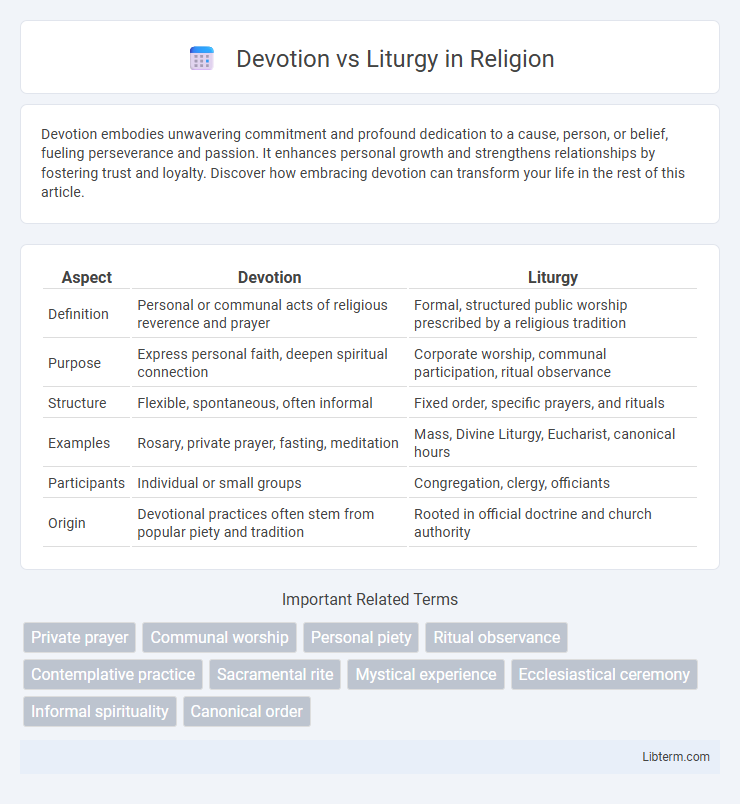Devotion embodies unwavering commitment and profound dedication to a cause, person, or belief, fueling perseverance and passion. It enhances personal growth and strengthens relationships by fostering trust and loyalty. Discover how embracing devotion can transform your life in the rest of this article.
Table of Comparison
| Aspect | Devotion | Liturgy |
|---|---|---|
| Definition | Personal or communal acts of religious reverence and prayer | Formal, structured public worship prescribed by a religious tradition |
| Purpose | Express personal faith, deepen spiritual connection | Corporate worship, communal participation, ritual observance |
| Structure | Flexible, spontaneous, often informal | Fixed order, specific prayers, and rituals |
| Examples | Rosary, private prayer, fasting, meditation | Mass, Divine Liturgy, Eucharist, canonical hours |
| Participants | Individual or small groups | Congregation, clergy, officiants |
| Origin | Devotional practices often stem from popular piety and tradition | Rooted in official doctrine and church authority |
Understanding Devotion: A Personal Spiritual Path
Devotion is a personal and intimate form of spiritual practice that emphasizes individual connection with the divine through prayer, meditation, and rituals tailored to personal beliefs. Unlike liturgy, which follows formal, communal worship structures prescribed by religious traditions, devotion allows for flexible expressions of faith that nurture inner spirituality. Understanding devotion highlights its role in fostering a unique and heartfelt relationship with God outside the boundaries of institutionalized worship.
Defining Liturgy: Structured Communal Worship
Liturgy is defined as a structured form of communal worship characterized by set rituals, prayers, and ceremonies performed regularly within religious communities. It provides a formal framework that fosters unity, shared belief expression, and continuity in spiritual practice across congregations. This organized approach contrasts with personal devotion by emphasizing collective participation and adherence to established liturgical patterns.
Historical Roots: Devotion and Liturgy Through the Ages
Devotion and liturgy both trace their historical roots to early Christian worship practices, where private prayers and formalized communal rites coexisted. Devotion evolved as personalized expressions of faith, such as the Rosary and Stations of the Cross, gaining prominence in medieval Christianity. Liturgy developed through structured rituals, codified in Church councils, reflecting standardized worship in sacred spaces and shaping ecclesiastical traditions over centuries.
Core Differences: Personal vs. Corporate Spirituality
Devotion represents a personal, intimate practice involving individual prayer, meditation, or rituals that foster a direct spiritual connection tailored to one's beliefs and emotions. Liturgy, in contrast, encompasses structured, formal worship services conducted corporately, following established rites and traditions designed to unify participants within a religious community. The core difference lies in devotion's emphasis on personal spirituality versus liturgy's role in expressing collective faith and shared religious identity.
The Role of Ritual in Liturgy
Ritual plays a central role in liturgy by providing structured and symbolic actions that foster communal worship and spiritual focus. Unlike personal devotion, liturgical rituals follow established forms that connect participants to historical traditions and theological meanings. These rituals help convey sacred narratives and reinforce collective identity within religious communities.
Spontaneity in Devotion: Expressions and Practices
Devotion emphasizes spontaneous expressions such as personal prayers, chants, and informal rituals that reflect individual emotions and experiences. These practices often involve impromptu gestures like singing, dancing, or offering flowers, fostering a direct and heartfelt connection with the divine. Unlike structured liturgy, devotion encourages flexible participation, allowing practitioners to adapt expressions based on personal inspiration and communal ambiance.
Impact on Faith Communities: Unity and Diversity
Devotion fosters personal piety and intimate expressions of faith, enhancing individual spiritual experiences within communities, while liturgy provides structured, communal worship that reinforces shared beliefs and traditions. Together, they balance unity and diversity by allowing personalized practices alongside unified rituals, strengthening community bonds and cultural identity. This interplay supports faith communities in embracing varied spiritual expressions without compromising collective coherence and doctrinal consistency.
Devotion and Liturgy in Modern Religious Life
Devotion in modern religious life emphasizes personal, heartfelt practices such as prayer, meditation, and rituals that foster individual spiritual growth and connection to the divine. Liturgy, on the other hand, represents structured, communal worship services guided by established traditions and prescribed rites within religious institutions. The interplay between devotion and liturgy shapes contemporary faith experiences by balancing personal spirituality with collective expressions of belief.
Common Overlaps: Where Devotion Meets Liturgy
Devotion and liturgy often intersect in the shared use of prayers, hymns, and rituals that foster communal and personal expressions of faith. Both practices emphasize reverence, sacred symbols, and structured forms of worship that reinforce religious identity and spirituality. Common elements such as the rosary, veneration of saints, and Eucharistic adoration highlight the blending of private devotion within formal liturgical settings.
Choosing Your Path: Integrating Devotion and Liturgy
Choosing your path in faith involves harmonizing personal devotion with structured liturgy to deepen spiritual experience. Devotion emphasizes intimate, individualized expression through prayer and meditation, while liturgy provides communal, ritualistic order fostering unity and tradition. Balancing both enriches worship by blending heartfelt connection with shared religious heritage.
Devotion Infographic

 libterm.com
libterm.com